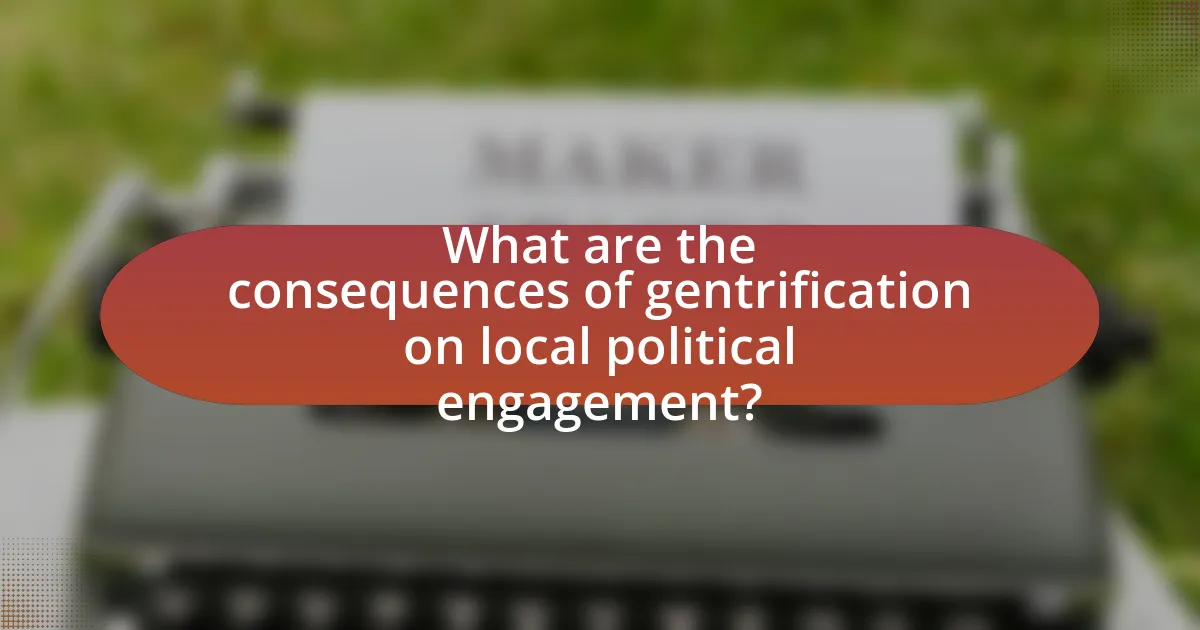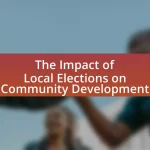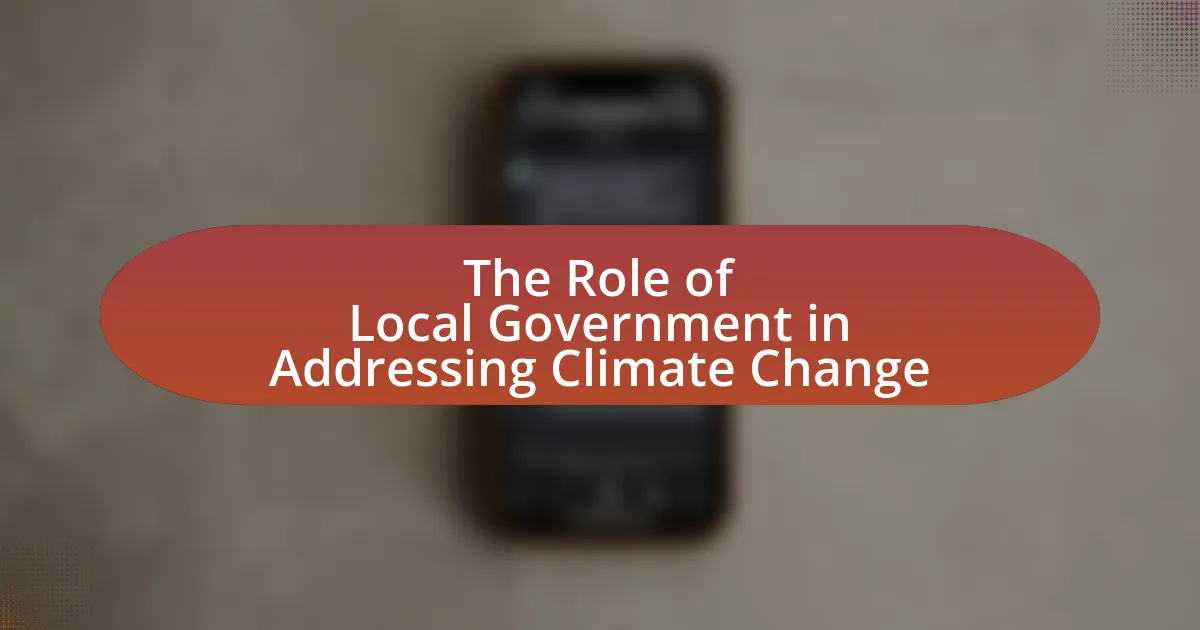The article examines the impact of gentrification on local political dynamics, highlighting how demographic shifts influence power structures and policy priorities. It discusses the increased political engagement of new, often wealthier residents who advocate for changes that reflect their interests, such as improved public services and housing development. The article also explores how local governance adapts to these changes, often prioritizing the needs of newcomers over long-standing community members, leading to significant shifts in local policies and community needs. Additionally, it addresses the role of local political leaders, the effects on voter behavior, and the emergence of social movements in response to gentrification, emphasizing the importance of understanding these dynamics for equitable community development.

What is the Effect of Gentrification on Local Political Dynamics?
Gentrification significantly alters local political dynamics by shifting power structures and influencing policy priorities. As wealthier residents move into previously lower-income neighborhoods, they often advocate for changes that reflect their interests, such as improved public services and infrastructure. This demographic shift can lead to increased political engagement among new residents, who may prioritize issues like housing development and public safety, thereby reshaping local governance. Studies have shown that areas experiencing gentrification often see a rise in voter turnout and participation in local elections, which can result in the election of officials who align with the interests of the new population. For instance, research from the Urban Institute indicates that gentrifying neighborhoods often experience changes in local leadership and policy focus, reflecting the preferences of incoming residents rather than long-standing community members.
How does gentrification influence local governance?
Gentrification influences local governance by shifting political priorities and resource allocation towards the interests of new, often more affluent residents. As neighborhoods undergo gentrification, local governments may prioritize development projects that cater to these newcomers, such as upscale housing and amenities, while neglecting the needs of long-standing, lower-income residents. This shift can lead to changes in zoning laws and increased investment in infrastructure, reflecting the desires of the gentrifying population. For instance, a study by the Urban Institute found that cities experiencing gentrification often see a rise in property values and tax revenues, prompting local officials to focus on policies that attract further investment, sometimes at the expense of affordable housing initiatives.
What changes occur in local policies due to gentrification?
Gentrification leads to significant changes in local policies, primarily aimed at accommodating new, often wealthier residents while addressing the needs of existing communities. Local governments may implement policies that promote affordable housing initiatives, zoning changes to allow for higher-density developments, and increased investment in public infrastructure and services to attract businesses and improve neighborhood appeal. For instance, cities like San Francisco have adopted inclusionary zoning laws that require developers to include affordable units in new projects, reflecting a response to the pressures of gentrification. Additionally, local policies may shift towards enhanced property tax assessments, which can generate revenue but also risk displacing long-term residents. These policy changes are often driven by the need to balance economic growth with social equity, as seen in various urban areas experiencing rapid gentrification.
How do community needs shift in response to gentrification?
Community needs shift in response to gentrification by prioritizing services and resources that cater to a more affluent demographic, often at the expense of long-standing residents. As property values rise and new businesses emerge, the focus may shift towards upscale amenities, such as boutique shops and fine dining, while essential services like affordable housing and community health resources become marginalized. Research indicates that in neighborhoods undergoing gentrification, the displacement of lower-income residents leads to a demand for different types of public services, reflecting the interests of new, wealthier inhabitants rather than those of the original community. For instance, a study by the Urban Institute found that gentrifying areas often see a decrease in affordable housing units, which directly impacts the community’s need for accessible living options.
Why is understanding local political dynamics important in the context of gentrification?
Understanding local political dynamics is crucial in the context of gentrification because these dynamics shape policy decisions that directly impact community development and displacement. Local governments often respond to gentrification through zoning laws, housing policies, and funding allocations, which can either mitigate or exacerbate the effects of gentrification. For instance, cities like San Francisco have implemented policies aimed at protecting low-income residents from displacement, demonstrating how political decisions can influence the trajectory of gentrification. Additionally, community engagement in local politics can empower residents to advocate for their needs, ensuring that development benefits existing communities rather than displacing them.
What role do local political leaders play in gentrification processes?
Local political leaders significantly influence gentrification processes by shaping policies that either facilitate or hinder urban redevelopment. These leaders often promote initiatives such as zoning changes, tax incentives, and infrastructure investments that attract developers and new residents, thereby accelerating gentrification. For instance, in cities like San Francisco, local government policies have been linked to rising property values and displacement of long-term residents, as seen in the 2010-2020 period when the city experienced a dramatic increase in housing costs due to pro-development policies. Additionally, local leaders may engage in community outreach to garner support for gentrification projects, often framing them as necessary for economic growth, which can further entrench the gentrification process.
How do residents’ political engagement levels change during gentrification?
Residents’ political engagement levels typically increase during gentrification. This rise in engagement is often driven by the displacement fears and changes in community demographics that gentrification brings. Research indicates that as neighborhoods undergo gentrification, long-term residents may mobilize to advocate for their interests, leading to increased participation in local governance, community meetings, and protests. For instance, a study by the Urban Institute found that in gentrifying areas, there is a notable uptick in voter registration and turnout among existing residents, reflecting their heightened awareness and response to the socio-economic changes affecting their community.

What are the key factors driving the political dynamics of gentrification?
The key factors driving the political dynamics of gentrification include economic investment, housing policy, and community displacement. Economic investment often leads to increased property values and attracts new businesses, which can shift the political priorities of local governments towards development and revitalization efforts. Housing policy, particularly zoning laws and tax incentives, can facilitate gentrification by making it easier for developers to convert low-income housing into upscale residences. Community displacement occurs as long-term residents are pushed out due to rising costs, leading to political mobilization among affected populations who may advocate for affordable housing and tenant protections. These dynamics are evidenced by studies showing that neighborhoods undergoing gentrification often experience changes in local governance and policy focus, reflecting the interests of new, often more affluent residents.
How do economic changes impact local political landscapes?
Economic changes significantly influence local political landscapes by altering voter priorities and shifting power dynamics. For instance, gentrification often leads to increased property values and a changing demographic, which can result in the displacement of long-term residents. This displacement can mobilize communities to advocate for policies that protect their interests, thereby reshaping local political agendas. Research indicates that areas experiencing gentrification see a rise in political engagement among both new and existing residents, as they seek to influence decisions on housing, public services, and community resources. A study by the Urban Institute found that neighborhoods undergoing economic transformation often witness changes in local leadership and policy focus, reflecting the interests of newer, often more affluent constituents.
What economic indicators are most affected by gentrification?
Gentrification primarily affects economic indicators such as property values, rental prices, and income levels. As neighborhoods undergo gentrification, property values typically increase due to demand from higher-income residents, leading to a rise in rental prices. For instance, a study by the National Community Reinvestment Coalition found that gentrifying neighborhoods in cities like San Francisco and New York saw property values increase by as much as 30% over a decade. Additionally, median household incomes in these areas often rise as new businesses cater to wealthier residents, further altering the economic landscape.
How do these economic changes influence voter behavior?
Economic changes, particularly those driven by gentrification, significantly influence voter behavior by altering demographics and shifting priorities within communities. As neighborhoods undergo economic transformation, often leading to increased property values and a change in the socioeconomic status of residents, long-term residents may feel marginalized and disenfranchised. This shift can lead to increased political engagement among new residents who may prioritize different issues, such as affordable housing and local business support, compared to the original community members who may focus on preserving cultural identity and social services. Studies have shown that areas experiencing gentrification often see a rise in voter turnout, as new residents become more politically active in response to the changes affecting their living conditions. For instance, research from the Urban Institute indicates that neighborhoods undergoing gentrification can experience a 10-20% increase in voter participation, reflecting the heightened political awareness and engagement among newer, often younger, residents.
What social factors contribute to shifts in political dynamics during gentrification?
Social factors such as demographic changes, community displacement, and shifting economic interests contribute to shifts in political dynamics during gentrification. As wealthier individuals move into previously lower-income neighborhoods, the demographic composition alters, often leading to a decline in political representation for long-standing residents. This demographic shift can result in new political priorities that favor the interests of newcomers, such as increased investment in infrastructure and services that cater to affluent populations. Additionally, community displacement due to rising property values and rents can lead to social unrest and mobilization among displaced residents, prompting them to advocate for policies that protect their rights and interests. Studies, such as those by the Urban Institute, have shown that these social dynamics can significantly influence local governance and policy-making, as new residents often have different political agendas compared to the original community members.
How does demographic change affect local political representation?
Demographic change significantly affects local political representation by altering the composition of the electorate and influencing policy priorities. As populations shift due to factors like gentrification, areas may experience an influx of new residents with different socioeconomic backgrounds, cultural values, and political preferences. For instance, research indicates that neighborhoods undergoing gentrification often see an increase in more affluent, younger residents who may prioritize issues such as housing development and public amenities over the needs of long-standing, lower-income communities. This shift can lead to a misalignment between elected officials and the interests of diverse constituents, as seen in cities like San Francisco, where the political landscape has transformed in response to demographic changes, resulting in policies that may favor new residents over existing ones.
What social movements arise in response to gentrification?
Social movements that arise in response to gentrification include anti-gentrification coalitions, tenant rights organizations, and community land trusts. These movements aim to combat displacement, advocate for affordable housing, and preserve local culture. For instance, organizations like the Right to the City Alliance mobilize communities to resist gentrification by promoting policies that protect low-income residents. Additionally, tenant unions, such as the Los Angeles Tenants Union, work to empower renters against eviction and rent hikes, highlighting the need for stronger tenant protections. Community land trusts, like the Dudley Street Neighborhood Initiative in Boston, seek to maintain community control over land and housing, ensuring that development benefits existing residents rather than outside investors.

What are the consequences of gentrification on local political engagement?
Gentrification leads to increased political engagement among new residents while often marginalizing long-term community members. As wealthier individuals move into a neighborhood, they tend to become more involved in local governance, advocating for policies that reflect their interests, such as improved infrastructure and public services. This shift can result in a dilution of the political power of existing residents, who may feel alienated or disenfranchised. Studies, such as those conducted by the Urban Institute, indicate that neighborhoods undergoing gentrification often see a rise in voter turnout and participation in local meetings, but this engagement is frequently skewed towards the priorities of newer, more affluent residents, thereby impacting local political dynamics significantly.
How does gentrification affect voter turnout in local elections?
Gentrification typically leads to increased voter turnout in local elections. This phenomenon occurs as new, often more affluent residents move into previously lower-income neighborhoods, bringing with them different political priorities and engagement levels. Research indicates that areas undergoing gentrification experience a rise in civic participation, as new residents are more likely to vote compared to long-term residents who may feel disenfranchised. For example, a study by the Urban Institute found that neighborhoods experiencing gentrification saw a 10-15% increase in voter registration and turnout rates during local elections, highlighting the impact of demographic shifts on political engagement.
What demographic groups experience changes in voting patterns?
Demographic groups that experience changes in voting patterns include young voters, racial and ethnic minorities, and low-income residents. Young voters often shift their preferences based on issues like climate change and social justice, while racial and ethnic minorities may change their voting behavior in response to local policies affecting their communities. Low-income residents frequently alter their voting patterns due to economic pressures and gentrification, which can lead to displacement and changes in local representation. Studies have shown that these groups are increasingly mobilized by specific issues, reflecting broader societal changes and local political dynamics.
How do new residents influence local electoral outcomes?
New residents significantly influence local electoral outcomes by shifting demographic trends and altering voting patterns. As gentrification occurs, new residents often bring different political preferences and priorities, which can lead to changes in local policies and candidate support. For instance, research indicates that areas experiencing gentrification tend to see increased voter turnout and a preference for progressive candidates, reflecting the values of the incoming population. A study by the Urban Institute found that neighborhoods undergoing gentrification often witness a rise in civic engagement, as new residents become more involved in local governance and advocacy, thereby reshaping the electoral landscape.
What strategies can communities employ to navigate political changes due to gentrification?
Communities can employ strategies such as grassroots organizing, coalition building, and advocacy for policy changes to navigate political changes due to gentrification. Grassroots organizing enables residents to mobilize and voice their concerns, fostering a sense of community solidarity. Coalition building with local organizations and stakeholders can amplify their influence and create a united front against displacement. Additionally, advocating for policies like rent control, affordable housing initiatives, and community land trusts can help protect vulnerable populations from the adverse effects of gentrification. These strategies have been effective in various cities; for instance, the establishment of community land trusts in cities like Burlington, Vermont, has successfully preserved affordable housing amidst rising property values.
How can local organizations advocate for equitable policies?
Local organizations can advocate for equitable policies by engaging in community mobilization, conducting research to highlight disparities, and forming coalitions with other stakeholders. Community mobilization involves organizing residents to voice their needs and concerns, which can influence local government decisions. Research, such as studies showing the impact of gentrification on housing affordability, provides evidence that can support policy changes. Forming coalitions allows organizations to pool resources and amplify their advocacy efforts, increasing their influence on policymakers. For instance, the National Community Reinvestment Coalition has documented how collective advocacy can lead to more equitable housing policies.
What role does community organizing play in political engagement?
Community organizing plays a crucial role in political engagement by mobilizing individuals to advocate for their collective interests and influence policy decisions. This grassroots approach empowers marginalized communities, enabling them to articulate their needs and concerns effectively. Research indicates that organized communities are more likely to participate in local governance, as evidenced by the increased voter turnout and civic participation observed in neighborhoods with active organizing efforts. For instance, a study by the National Community Reinvestment Coalition found that community organizing initiatives led to a 30% increase in voter registration in targeted areas, demonstrating the direct impact of such efforts on political engagement.
What best practices can be adopted to ensure inclusive political dynamics during gentrification?
To ensure inclusive political dynamics during gentrification, community engagement and participatory planning should be prioritized. Engaging local residents in decision-making processes allows their voices to be heard and considered, fostering a sense of ownership and representation. For instance, cities like San Francisco have implemented community advisory boards that include long-term residents to guide development projects, ensuring that their needs and concerns are addressed. Additionally, policies that protect affordable housing and prevent displacement, such as rent control and tenant protections, can help maintain the socio-economic diversity of neighborhoods. Research indicates that inclusive policies can mitigate the negative impacts of gentrification, as seen in studies conducted by the Urban Institute, which highlight the importance of equitable development strategies.




